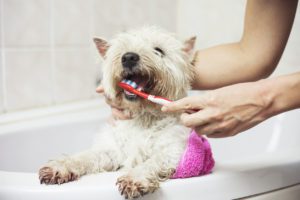Symptoms of Dog Dental Disease in Wilton Manors, FL
Did you know dogs are prone to gum disease more than humans? Dogs are five times more likely to get gum disease more than humans because their mouth contains more alkaline, which promotes plaques and dogs don’t brush their teeth daily. Dogs can also fracture their teeth, which can cause a lot of pain.
The most common dental disease is periodontal disease. It may be threating to your pooch’s oral health in addition to their overall health. Usually you wouldn’t be able to see any signs but would slowly see them as the disease reaches its advance stages. Gum disease would cause gum erosion, tooth loss, weak gums, weakness of bone structure holding the teeth and chronic tooth pain.
Even with a cracked tooth, your dog may not show any sign of pain. In fact, they may eat, drink and behave normally, acting like the same happy dog you know and love.

What Causes Periodontal Disease?
Over 80 percent of dogs show early stages of gum diseases by the time they are three years. Periodontal disease happens when reaming food particles are left in some parts of the gum or teeth and bacteria begins to build up along the gums, forming plaque, which turns into tartar- also known as calculus. The tartar causes inflammation and irritation of the gums.
Over time, the tartar would build under the gums, which would cause the teeth to separate. Bacteria would then slowly grow in between the spaces in the teeth, which causes the gum to go weak and might lead to several more health problems.
Poor nutrition in your dog’s diet can play a huge role in the development of periodontal disease. As well as environmental habits like poor grooming habits, your dog is always licking itself constantly, dirty toys, chewing behavior and oral hygiene.
The alignment of your dog’s teeth can also be a problem. Small breeds with crowded teeth are more susceptible to gum disease.
Here are some lists of dogs that are prone to dental diseases:
- Chihuahuas
- Yorkshire Terriers
- Shetland Sheepdogs
- Brachycephalic (Short-faced) Dogs
- Smaller Poodle mixes
- Malteses
- Italian Greyhounds
- Pomeranians
- Cavalier King Charles Spaniels
Plaques and calculus tend to build up quickly in smaller mouth as and should be addressed as soon as possible.
Here are Dental Disease Symptoms:
- Bad Breath
- Loss of appetite
- Bleeding or red gums
- Difficulty eating
- Irritability
- Excessive drooling
- Loose teeth or teeth falling out
- Inflamed gums
- Blood in drinking bowls and on toys
- Weight loss
- Discolored teeth (brown or yellow)
- Head shyness
- Bumps or lumps in mouth
- Nasal discharge and sneezing
The effects of periodontal disease can lead to problems concerning the major organs, like the kidney, liver and heart. When bacteria is present in the mouth, it can enter the bloodstream, then attach itself to the arteries surrounding the heart.
Stages of the Periodontal Disease in Dogs
Sometimes the symptoms of periodontal disease are not that easy to notice until the gum disease progresses to the more advance stage. That’s why dog owners should check their dog’s mouth regularly for anything out the ordinary.
Periodontal disease begins at an early stage. One tooth is only affected, and it progresses from there. In stage 1 periodontal disease, dogs would show a sign of gingivitis- which causes irritation, redness and swelling at the part of their gum that is around the base of your dog’s teeth.
In stage 2, up to 25 percent of the attachment between the teeth and the gums would being to weaken and be lost. As dogs progress to stage 3 of periodontal disease, the attachment loss has grown to 30 percent.
Stage 4 is the final stage, which is also known as the advanced stage of periodontal disease, more the 50 percent of the attachment between the teeth and gums have weaned, the tissue of the gums become weak, the roots of the teeth slowly begin to expose causing more irritation, lumps and pain.
How Are Dogs Treated From Periodontal Disease?
The cost of dental care such as teeth cleaning, collecting blood samples may vary depending on the level of care provided by your veterinarian. Your pet would have to get blood work before given anesthesia. This way they can ensure your pet is healthy enough for the procedure.
The treatment for periodontal disease in dogs begins with an x-ray exam to determine which stage your dog is in and what damages it has caused. Your vet might give some antibiotics to prevent any further spreading of the bacteria during dental work. Treatments given depend on the result of the stages and which part of the body it has affected.
For stages 1 and 2 of periodontal disease, a thorough cleaning of the mouth can remove built up plague and the tartar can be removed by a device called ultrasonic scaler. The vet will then polish the teeth to fill crevices so bacteria cannot attach itself to any area of the teeth and form plaque.
In stages 3 and 4 of periodontal disease, your dog would still require a full clean up in the mouth and some further treatment.
There are several types of procedures that may be used:
- IV catheter and IV fluids
- Anesthesia monitoring
- Planning and subgingival curettage- Removal of diseased teeth and smoothens the surface of the roots.
- Pre-anesthesia blood work
- Local anesthesia, e.g. novocaine
- Endotracheal intubation
- Gingivectomy and periodontal surgery- can remove diseased gums and can open affected gums to clean, treat and provide with bone growth stimulation.
In some cases, removal of decaying teeth, cracked or loose teeth is necessary. The vet might prescribe pain relief medication and a give list of soft foods that can be easily digested by your dog for three to four weeks.

How Do I Prevent My Dog From Getting Dental Disease?
Taking care of your pooch’s teeth is like taking care of your own. Many vets recommend:
- Daily tooth brushing: Cleaning your dog’s teeth every day would prevent oral diseases. All you’ll need is a pet toothpaste and a clean cloth.
- Good quality food: Visit the vet for advice on a dental diet. This means getting your dog food that has additives that help prevent plaque and help scrub your dog’s teeth while chewing.
- Annual oral examination: Visit the vet to check your dog’s mouth for any built up bacteria.
You could also check at home. Here are steps to check your dog’s mouth at home:
- Listen for chattering jaws when your dog is chewing.
- Look for discolored or broken teeth.
- Notice if your dog is avoiding food.
- Look for bleeding on chew toys or water bowl.
- Check for any bumps or lumps in the mouth
- Check if you perceive any mouth odor
If you see any of these issues, it’s not too late to call our veterinarian at (954) 565-1896 or Make An Appointment.
